On the Implementation of the Nearly Zero Energy Building Concept for Jointly Acting Renewables Self-Consumers in Mediterranean Climate Conditions
Abstract
:1. Introduction
2. Materials and Methods
2.1. Description of Collective Self-Consumption nZEB under Study
2.2. Definition of the Energy Consumption Profiles
2.2.1. Thermal Energy Consumption (for Heating) Calculation
2.2.2. Thermal Energy Consumption (for Cooling) Calculation
2.2.3. Electrical Energy Consumption Calculation
2.3. Geothermal Energy System Design
2.4. PV System Design
2.5. Sizing of the Electrical Energy Storage Unit
2.6. Optimal EESU Sizing
3. Techno-Economic Analysis and Discussions
3.1. The LCCA Method
- (a)
- the Initial Cost (IC) of the investment, and
- (b)
- the payback period of the proposed investment.
3.2. LCCA of the Proposed Energy System
3.2.1. LCCA of the Building Energy Consumption
3.2.2. LCCA of the PV System
3.2.3. LCCA of the Geothermal Energy System
3.2.4. LCCA of the TES Unit
3.2.5. LCCA of the EESU
4. Conclusions
Author Contributions
Funding
Conflicts of Interest
Nomenclature
| AC | Alternative Current |
| ASHP | Air-source heat pump |
| BAPV | Building Applied Photovoltaic System |
| BEA | Building Energy Analysis |
| BHEs | Borehole heat exchangers |
| BIPV | Building Integrated Photovoltaic System |
| BIPV/T | Building Integrated Photovoltaic/Thermal system |
| CCHP | Combined cooling, heating and power system |
| CHP | Cooling, heating and power system or cogeneration system |
| CO2 | Carbon dioxide |
| COP | Coefficient of performance |
| Cstorage | Storage capacity (kWhe) |
| Cstorage,ref | Reference value of storage capacity (kWhe) |
| d | Discount rate (%) |
| D | Down payment (%) |
| DHW | Domestic hot water |
| DSO | Distribution System Operator |
| e | Escalation of energy costs (%) |
| e(K) | Cost function of optimal storage capacity |
| E | Annual cost of the energy (€) |
| EABSORBED | Absorbed energy (€) |
| EAHP | Exhaust air heat pump |
| EER | Energy efficiency ratio |
| EESU | Electrical energy storage unit |
| ESS | Energy storage system |
| ESUs | Energy storage units |
| EU | European Union |
| g | Inflation rate (%) |
| GCHP | Gound-coupled heat pump |
| GDHS | Geothermal district heating system |
| GHEs | Geothermal heat exchangers or Ground heat exchangers |
| GHP | Geothermal heat pump |
| GSHP | Ground-source heat pump |
| GWHP | Ground-water heat pump |
| HEDNO | Hellenic Electricity Distribution Network Operator |
| HPSU | Heat pump storage unit |
| HVAC | Heating, ventilation and air-conditioning |
| i | Borrowing rate (%) |
| I | Funding of the investment (%) |
| IC | Initial Cost (€) |
| K | Normalized variable |
| LCCTOTAL | Total life cycle cost of the building (€) |
| LCCA | Life Cycle Cost Assessment |
| Li-ion | Lithium iodide battery |
| LPG | Liquified Pretroleum Gas |
| LVDS | Low Voltage Distribution System |
| N | Period of analysis (years) |
| N1 | The minimum between N and N1 (years) |
| NΔ | Borrowing period (years) |
| nZEB | nearly Zero Energy Building |
| OM | Operation and Maintenace (€) |
| PV | Photovoltaic system |
| PV | Present Value (€) |
| PVABSORBED | Present value of absorbed energy (€) |
| PVENER | Present value of the energy cost that is supplied by the grid (€) |
| PVINT | Present value of the annual interest (€) |
| PVITC | Present value of the funding of the investment (€) |
| PVLOAN | Present value of the lean installment (€) |
| PVMISC | Present value of the various costs during the life cycle, such as maintenance costs (€) |
| PVREP | Present value of the replacement costs (€) |
| PVSYS | Present value of total system cost (€) |
| PVSV | Present value of the system remaining value at the end of the period of analysis (€) |
| PVTOTAL | Total present value of the investment (€) |
| PVF | Present Value Function (€) |
| PV/GHP | Photovoltaic/Geothermal heat pump system |
| PV/ST | Photovoltaic/Solar thermal system |
| PV/T | Photovoltaic/Thermal system |
| r | The number of replacements during the analysis period |
| R | Replacement cost of a subsystem with reference to the first year of operation (€) |
| RES | Renewable Energy Sources |
| SOCmax | Maximum State of Charge value (%) |
| SOCmin | Mimimum State of Charge value (%) |
| STC | Standard Test Conditions |
| t | Income tax (%) |
| TES | Thermal energy storage |
| UTES | Underground thermal energy storage |
| WPP | Wind power plant |
| X | Any investment to be analyzed (€) |
| ΔEgrid, month | Absolute value of the maximum energy transaction between the building and the electricity grid during the 10 – years period (kWhe) |
| ΔEgrid, month,ref | Reference value of maximum energy transaction between the building and the electricity grid during the 10 – years period (kWhe) |
| ΔEpeak-to-peak | Peak-to-peak stored energy fluctuation in EESU (kWhe) |
| ΔEstorage, month | Maximum permitted energy fluctuation in the EESU per month (kWhe) |
| ΔEstorage, month,ref | Reference value of maximum permitted energy fluctuation in the EESU per month (kWhe) |
References
- D’ Agostino, D.; Mazzarella, L. What is a Nearly zero energy building? Overview, implementation and comparison of definitions. J. Build. Eng. 2019, 21, 200–212. [Google Scholar] [CrossRef]
- Green Paper, A 2030 Framework for Climate and Energy Policies COM 169. Available online: https://eur-lex.europa.eu/legal-content/EN/TXT/PDF/?uri=CELEX:52013DC0169&from=EN (accessed on 23 January 2020).
- EU. Directive 2010/31/EU 2010 of the European Parliament and of the Council of 19 May 2010 on the Energy Performance of Buildings (recast). Available online: https://eur-lex.europa.eu/legal-content/EN/TXT/PDF/?uri=CELEX:32010L0031&from=el (accessed on 10 January 2020).
- EU. Directive 2018/844 of the European Parliament and of the Council of 30 May 2018, Amending Directive 2010/31/EU on the Energy Performance of Buildings and Directive 2012/27/EU on Energy Efficiency. Available online: https://eur-lex.europa.eu/legal-content/EN/TXT/?uri=uriserv%3AOJ.L_.2018.156.01.0075.01.ENG (accessed on 7 February 2020).
- Kyritsis, A.; Mathas, E.; Antonucci, D.; Grottke, Μ.; Tselepis, S. Energy improvement of office buildings in Southern Europe. Energy Build. 2016, 123, 17–33. [Google Scholar] [CrossRef]
- Carli, R.; Dotoli, M. Decentralized control for residential energy management of a smart users ’ microgrid with renewable energy exchange. IEEE/CAA J. Autom. Sin. 2019, 6, 641–656. [Google Scholar] [CrossRef]
- Geidl, M.; Koeppel, G.; Favre-Perrod, P.; Klockl, B.; Andersson, G.; Frohlich, K. Energy hubs for the future. IEEE Power Energy Mag. 2007, 5, 24–30. [Google Scholar] [CrossRef]
- Hosseini, S.M.; Carli, R.; Dotoli, M. Robust Day-Ahead Energy Scheduling of a Smart Residential User Under Uncertainty. In Proceedings of the 2019 18th European Control Conference (ECC), Naples, Italy, 25–28 June 2019; pp. 935–940. [Google Scholar] [CrossRef]
- Park, S.; Salkuti, S.R. Optimal Energy Management of Railroad Electrical Systems with Renewable Energy and Energy Storage Systems. Sustainability 2019, 11, 6293. [Google Scholar] [CrossRef] [Green Version]
- EU. Directive 2018/2001 of the European Parliament and of the Council of 11 December 2018 on the Promotion of the Use of Energy from Renewable Sources (Recast). Available online: https://eur-lex.europa.eu/legalcontent/EN/TXT/PDF/?uri=CELEX:32018L2001&qid=1580204680261&from=EN (accessed on 10 January 2020).
- CEER Report C18-CRM9_DS7-05-03, 25. Regulatory Aspects of Self-Consumption and Energy Communities, Council of European Energy Regulators Asbl. Available online: https://www.ceer.eu/documents/104400/-/-/8ee38e61-a802-bd6f-db27-4fb61aa6eb6a (accessed on 10 January 2020).
- Marsza, A.J.; Heiselberg, P.; Bourrelle, J.S.; Musall, E.; Voss, K.; Sartori, I.; Napolitano, A. Zero Energy Building–A review of definitions and calculation methodologies. Energy Build. 2011, 43, 971–979. [Google Scholar] [CrossRef]
- Cao, X.; Dai, X.; Liu, J. Building energy-consumption status worldwide and the state of- the-art technologies for zero-energy buildings during the past decade. Energy Build. 2016, 128, 198–213. [Google Scholar] [CrossRef]
- Semprini, G.; Gulli, R.; Ferrante, A. Deep regeneration vs shallow renovation to achieve nearly Zero Energy in existing buildings: Energy saving and economic impact of design solutions in the housing stock of Bologna. Energy Build. 2017, 156, 327–342. [Google Scholar] [CrossRef]
- Ferrante, A.; Cascella, M.T. Zero energy balance and zero on-site CO2 emission housing development in the Mediterranean climate. Energy Build. 2011, 43, 2002–2010. [Google Scholar] [CrossRef]
- Ascione, F.; Borrelli, M.; Francesca De Masi, R.; de Rossi, F.; Vanoli, G.P. A framework for nZEB design in Mediterranean climate: Design, building and set-up monitoring of a lab-small villa. Sol. Energy 2019, 184, 11–29. [Google Scholar] [CrossRef]
- Gaglia, A.G.; Dialynas, E.N.; Argiriou, A.A.; Kostopoulou, E.; Laskos, K.M. Energy performance of European residential buildings: Energy use, technical and environmental characteristics of the Greek residential sector–energy conservation and CO₂ reduction. Energy Build. 2019, 183, 86–104. [Google Scholar] [CrossRef]
- Rey, F.J.; Velasco, E.; Varela, F. Building energy analysis (BEA): A methodology to assess building energy labeling. Energy Build. 2007, 39, 709–716. [Google Scholar] [CrossRef]
- Calero, M.; Alameda-Hernandez, E.; Fernández-Serrano, M.; Ronda, A.; Martín-Lara, M.Á. Energy consumption reduction proposals for thermal systems in residential buildings. Energy Build. 2018, 175, 121–130. [Google Scholar] [CrossRef]
- Pacheco, R.; Ordóñez, J.; Martínez, G. Energy efficient design of building: A review. Renew. Sustain. Energy Rev. 2012, 16, 3559–3573. [Google Scholar] [CrossRef]
- Feng, Y. Thermal design standards for energy efficiency of residential buildings in hot summer/cold winter zones. Energy Build. 2004, 36, 1309–1312. [Google Scholar] [CrossRef]
- Kampelis, N.; Gobakis, K.; Vagias, V.; Kolokotsa, D.; Standardi, L.; Isidori, D.; Cristalli, C.; Montagninoc, F.M.; Paredes, F.; Muratore, P.; et al. Evaluation of the performance gap in industrial, residential & tertiary near-Zero energy buildings. Energy Build. 2017, 148, 58–73. [Google Scholar] [CrossRef] [Green Version]
- Karlessi, T.; Kampelis, N.; Kolokotsa, D.; Santamouris, M.; Standardi, L.; Isidori, D.; Cristalli, C. The concept of smart an nZEB buildings and the integrated design approach. Procedia Eng. 2017, 180, 1316–1325. [Google Scholar] [CrossRef]
- Kalogirou, S.A.A.; Tripanagnostopoulos, Y. Hybrid PV/T solar systems for domestic hot water and electricity production. Energy Convers. Manag. 2006, 47, 3368–3382. [Google Scholar] [CrossRef]
- Yin, H.M.; Yang, D.J.; Kelly, G.; Garant, J. Design and performance of a novel building integrated PV/thermal system for energy efficiency of buildings. Sol. Energy 2013, 87, 184–195. [Google Scholar] [CrossRef]
- Delisle, V.; Kummert, M. A novel approach to compare building-integrated photovoltaics/thermal air collectors to side-by-side PV modules and solar thermal collectors. Sol. Energy 2014, 100, 50–65. [Google Scholar] [CrossRef]
- Agrawal, B.; Tiwari, G.N. Optimizing the energy and exergy of building integrated photovoltaic thermal (BIPVT) systems under cold climatic conditions. Appl. Energy 2010, 87, 417–426. [Google Scholar] [CrossRef]
- Kyritsis, A.; Roman, E.; Kalogirou, S.A.; Nikoletatos, J.; Agathokleous, R.; Mathas, E.; Tselepis, S. Households with Fibre Reinforced Composite BIPV modules in Southern Europe under Net Metering Scheme. Renew. Energy 2019, 137, 167–176. [Google Scholar] [CrossRef]
- López, P.C.S.; Frontini, F. Energy Efficiency and Renewable Solar Energy Integration in Heritage Historic Buildings. Energy Procedia 2014, 48, 1493–1502. [Google Scholar] [CrossRef] [Green Version]
- López, P.C.S.; Lucchi, E.; Franco, G. Acceptance of Building Integrated Photovoltaic (BIPV) in heritage buildings and landscapes: Potentials, barriers and assessment criteria. In Proceedings of the Rehabend Congress 2020, Construction Pathology, Rehabilitation Technology and Heritage Management, Granada, Spain, 24–27 March 2020. [Google Scholar]
- Jelle, B.P.; Breivik, C.; Drolsum Røkenes, H. Building integrated photovoltaic products: A state-of-the-art review and future research opportunities. Sol. Energy Mater. Sol. Cells 2012, 100, 69–96. [Google Scholar] [CrossRef] [Green Version]
- Cerón, I.; Caamaño-Martín, E.; Javier Neila, F. ‘State-of-the-art’ of building integrated photovoltaic products. Renew. Energy 2013, 58, 127–133. [Google Scholar] [CrossRef] [Green Version]
- Attoye, D.E.; Aoul, K.A.T.; Hassan, A. A Review on Building Integrated Photovoltaic Façade Customization Potentials. Sustainability 2017, 9, 1–24. [Google Scholar]
- Sánchez-Pantoja, N.; Vidal, R.; Carmen Pastor, M. Aesthetic perception of photovoltaic integration within new proposals for ecological architecture. Sustain. Cities Soc. 2018, 39, 203–214. [Google Scholar] [CrossRef]
- Ondeck, A.D.; Edgar, T.F.; Baldea, M. Optimal operation of a residential district-level combined photovoltaic/natural gas power and cooling system. Appl. Energy 2015, 156, 593–606. [Google Scholar] [CrossRef]
- Postnikov, I.; Stennikov, V.; Penkovskii, A. Integrated energy supply schemes on basis of cogeneration Plants and wind power plants. Energy Procedia 2019, 158, 154–159. [Google Scholar] [CrossRef]
- Lindenberger, D.; Bruckner, T.; Groscurth, H.M.; Kummel, R. Optimization of solar district heating systems: Seasonal storage, heat pumps, and cogeneration. Energy 2000, 25, 591–608. [Google Scholar] [CrossRef]
- Thygesen, R.; Karlsson, B. An analysis on how proposed requirements for near zero energy buildings manages PV electricity in combination with two different types of heat pumps and its policy implications–A Swedish example. Energy Policy 2017, 101, 10–19. [Google Scholar] [CrossRef]
- Alnaser, N.W. Building integrated renewable energy to achieve zero emission in Bahrain. Energy Build. 2015, 93, 32–39. [Google Scholar] [CrossRef]
- Thygesen, R.; Karlsson, B. Simulation and analysis of a solar assisted heat pump system with two different storage types for high levels of PV electricity self-consumption. Sol. Energy 2014, 103, 19–27. [Google Scholar] [CrossRef]
- Gong, H.; Rallabandi, V.; Ionel, D.M.; Colliver, D.; Duerr, S.; Ababei, C. Net Zero Energy Houses with Dispatchable Solar PV Power Supported by Electric Water Heater and Battery Energy Storage. In Proceedings of the 2018 IEEE Energy Conversion Congress and Exposition (ECCE), Portland, OR, USA, 23–27 September 2018; pp. 2498–2503. [Google Scholar] [CrossRef]
- Akter, M.N.; Mahmud, M.A.; Amanullah, M.T.O. Comprehensive economic analysis of a residential building with solar photovoltaic and battery energy storage system An Australian case study. Energy Build. 2017, 138, 332–346. [Google Scholar] [CrossRef]
- Blum, P.; Campillo, G.; Munch, W.; Kolbel, T. CO2 savings of ground source heat pump systems–A regional analysis. Renew. Energy 2010, 35, 122–127. [Google Scholar] [CrossRef]
- Sivasakthivel, T.; Murugesan, K.; Sahoo, P.K. Potential Reduction in CO2 Emission and Saving in Electricity by Ground Source Heat Pump System for Space Heating Applications-A Study on Northern Part of India. International Conference on Modeling Optimization and Computing (ICMOC -2012), April 10 & 11. Procedia Eng. 2012, 38, 970–979. [Google Scholar] [CrossRef] [Green Version]
- Lo Russo, S.; Boffa, C.; Civita, M.V. Low-enthalpy geothermal energy: An opportunity to meet increasing energy needs and reduce CO2 and atmospheric pollutant emissions in Piemonte, Italy. Geothermics 2009, 38, 254–262. [Google Scholar] [CrossRef]
- Knudstrup, M.A.; Ring-Hansen, H.T.; Brunsgaard, C. Approaches to the design of sustainable housing with low CO2 emission in Denmark. Renew. Energy 2009, 34, 2007–2015. [Google Scholar] [CrossRef]
- Kaushal, M. Geothermal cooling heating using GHE for various experimental and analytical studies: Comprehensive review. Energy Build. 2017, 139, 634–652. [Google Scholar] [CrossRef]
- Florides, G.; Kalogirou, S. Ground heat exchangers-a review of systems, models and applications. Renew. Energy 2007, 32, 2461–2478. [Google Scholar] [CrossRef]
- Self, S.J.; Reddy, B.V.; Rosen, M.A. Geothermal heat pump systems: Status review and comparison with other heating options. Appl. Energy 2013, 101, 341–348. [Google Scholar] [CrossRef]
- Niemelä, T.; Manner, M.; Laitinen, A.; Sivula, T.M.; Kosonen, R. Computational and experimental performance analysis of a novel method for heating of domestic hot water with a ground source peat pump system. Energy Build. 2018, 161, 22–40. [Google Scholar] [CrossRef] [Green Version]
- Zeng, H.Y.; Diao, N.R.; Fang, Z.H. Heat transfer analysis of boreholes in vertical ground heat exchangers. Int. J. Heat Mass Transf. 2003, 46, 4467–4481. [Google Scholar] [CrossRef]
- Fu, Y.; Haiyang, L.; Sun, K.; Sun, Q.; Wnnersten, R. A multi objective optimization of PV/ST-GSHP system based on office buildings. Energy Procedia 2018, 152, 71–76. [Google Scholar] [CrossRef]
- Fadejev, J.; Simson, R.; Kurnitski, J.; Kesti, J.; Mononen, T.; Lautso, P. Geothermal heat pump performance in a nearly zero-energy building. Energy Procedia 2016, 96, 489–502. [Google Scholar] [CrossRef]
- Lv, Y.; Si, P.; Liu, J.; Ling, W.; Yan, J. Performance of a Hybrid Solar Photovoltaic - Air Source Heat Pump System with Energy Storage. Energy Procedia 2018, 158, 1311–1316. [Google Scholar] [CrossRef]
- Lentz, A.; Almanza, R. Solar–geothermal hybrid system. Appl. Therm. Eng. 2006, 26, 1537–1544. [Google Scholar] [CrossRef]
- Zhou, C.; Doroodchi, E.; Moghtaderi, B. An in-depth assessment of hybrid solar–geothermal power generation. Energy Convers. Manag. 2013, 74, 88–101. [Google Scholar] [CrossRef]
- Li, H.; Xu, W.; Yu, Z.; Wu, J.; Yu, Z. Discussion of a combined solar thermal and ground source heat pump operation strategy for office heating. Energy Build. 2018, 162, 42–53. [Google Scholar] [CrossRef]
- Dai, L.; Li, S.; DuanMu, L.; Li, X.; Shang, Y.; Dong, M. Experimental performance analysis of a solar assisted ground source heat pump system under different heating operation modes. Appl. Therm. Eng. 2015, 75, 325–333. [Google Scholar] [CrossRef]
- Bi, Y.; Guo, T.; Zhang, L.; Chen, L. Solar and ground source heat-pump system. Appl. Energy 2004, 78, 231–245. [Google Scholar] [CrossRef]
- Trillat-Berdal, V.; Souyri, B.; Fraisse, G. Experimental study of a ground-coupled heat pump combined with thermal solar collectors. Energy Build. 2006, 38, 1477–1484. [Google Scholar] [CrossRef]
- Ozgener, O.; Hepbasli, A. Performance analysis of a solar assisted ground-source heat pump system for greenhouse heating: An experimental study. Build. Environ. 2005, 40, 1040–1050. [Google Scholar] [CrossRef]
- Rad, F.M.; Fung, A.S.; Leong, W.H. Feasibility of combined solar thermal and ground source heat pump systems in cold climate, Canada. Energy Build. 2003, 61, 224–232. [Google Scholar] [CrossRef]
- Sanner, B.; Karytsas, C.; Mendrinos, D.; Rybach, L. Current status of ground source heat pumps and underground thermal energy storage in Europe. Geothermics 2003, 32, 579–588. [Google Scholar] [CrossRef]
- Franco, A.; Fabio, F. Experimental analysis of a self-consumption strategy for residential building: The integration of PV system and geothermal heat pump. Renew. Energy 2016, 86, 1075–1085. [Google Scholar] [CrossRef]
- Ma, W.; Fang, S.; Liu, G. Hybrid optimization method and seasonal operation strategy for distributed energy system integrating CCHP, photovoltaic and ground source heat pump. Energy 2017, 141, 1439–1455. [Google Scholar] [CrossRef]
- Kolokotsa, D.; Kampelis, N.; Mavrigiannaki, A.; Gentilozzi, M.; Paredes, F.; Montagnino, F.; Venezia, L. On the integration of the energy storage in smart grids: Technologies and applications. Energy Storage 2019, 1. [Google Scholar] [CrossRef] [Green Version]
- Roberts, B.P.; Sandberg, C. The role of energy storage in development of smart grids. Proc. IEEE 2011, 99, 1139–1144. [Google Scholar] [CrossRef]
- Li, H.; Qu, L.; Qiao, W. Life-cycle cost analysis for wind power converters. In Proceedings of the 2017 IEEE International Conference on Electro Information Technology (EIT), Lincoln, NE, USA, 14–17 May 2017; pp. 630–634. [Google Scholar] [CrossRef]
- Silva, S.M.; Mateus, R.; Marques, L.; Ramos, M.; Almeida, M. Contribution of the solar systems to the nZEB and ZEB design concept in Portugal – Energy, economics and environmental life cycle analysis. Sol. Energy Mater. Sol. Cells 2016, 156, 59–74. [Google Scholar] [CrossRef] [Green Version]
- Jacob, A.S.; Das, J.; Abraham, A.P.; Banerjee, R.; Ghosh, P.C. Cost and Energy Analysis of PV Battery Grid Backup System for a Residential Load in Urban India. Energy Procedia 2017, 118, 88–94. [Google Scholar] [CrossRef]
- Marszal, A.J.; Heiselberg, P. Life cycle cost analysis of a multi-storey residential Net Zero Energy Building in Denmark. Energy 2011, 36, 5600–5609. [Google Scholar] [CrossRef]
- Ates, S.A. Life cycle cost analysis: An evaluation of renewable heating systems in Turkey. Energy Explor. Exploit. 2015, 33, 621–638. [Google Scholar] [CrossRef] [Green Version]
- Sullivan, J.L.; Clark, C.E.; Han, J.; Wang, M. Life-Cycle Analysis Results of Geothermal Systems in Comparison to Other Power Systems, Center for Transportation Research Energy Systems Division, Argonne National Laboratory August 2010. Available online: http://www.osti.gov/bridge (accessed on 10 January 2020).
- Yilmaz, C. Life cycle cost assessment of a geothermal power assisted hydrogen energy system. Geothermics 2020, 83, 101737. [Google Scholar] [CrossRef]
- Deng, Y.; Li, J.; Li, T.; Gao, X.; Yuan, C. Life cycle assessment of lithium sulfur battery for electric vehicles. J. Power Sources 2017, 343, 284–295. [Google Scholar] [CrossRef] [Green Version]
- Schoenung, S.M.; Hassenzahl, W.V. Long- vs. Short-Term Energy Storage Technologies Analysis A Life-Cycle Cost Study A Study for the DOE Energy Storage Systems Program, August, 2003. Available online: https://prod-ng.sandia.gov/techlib-noauth/access-control.cgi/2003/032783.pdf (accessed on 10 January 2020).
- Karanasios, E.; Ampatzis, M.; Nguyen, P.H.; Kling, W.L.; van Zwam, A. A model for the estimation of the cost of use of Li-Ion batteries in residential storage applications integrated with PV panels. In Proceedings of the 2014 49th International Universities Power Engineering Conference (UPEC), Cluj-Napoca, Romania, 2–5 September 2014; pp. 1–6. [Google Scholar] [CrossRef]
- Mehdijev, S. Dimensioning and Life Cycle Costing of Battery Storage System in Residential Housing-A Case Study of Local System Operator Concept. Master of Science Thesis, Project in Electric Power Engineering, Stockholm, Sweden, June 2017. Available online: http://www.diva-portal.org/smash/get/diva2:1130036/FULLTEXT01.pdf (accessed on 10 January 2020).
- Droutsa, P.; Kontogiannidis, S.; Dascalaki, E.; Blaras, C. Mapping the energy performance of hellenic residential buildings from EPC (energy performance certificate) data. Energy 2016, 98, 284–295. [Google Scholar] [CrossRef]
- EU. Commission Recommendation 2016/1318/EU of 29 July 2016 on Guidelines for the Promotion of Nearly Zero-Energy Buildings and Best Practices to Ensure That, by 2020, All New Buildings are Nearly Zero-Energy Buildings. Available online: https://eur-lex.europa.eu/legal-content/EN/TXT/PDF/?uri=CELEX:32016H1318&from=EL (accessed on 7 February 2020).
- Lucchi, E.; Tabak, M.; Troi, A. The “Cost Optimality” Approach for the Internal Insulation of Historic Buildings. Energy Procedia 2017, 133, 412–423. [Google Scholar] [CrossRef]
- Paduos, S.; Corrado, V. Cost-optimal approach to transform the public buildings into nZEBs: A European cross-country comparison. Energy Procedia 2017, 140, 314–324. [Google Scholar] [CrossRef]
- Hellenic Statistic Authority 2013. Survey on Energy Consumption in Households 2011-2012 Press Release. Available online: https://www.statistics.gr/documents/20181/985219/Energy+consumption+in+households/ (accessed on 10 January 2020).
- Braun, M.R.; Walton, P.; Beck, S.B.M. Illustrating the relationship between the coefficient of performance and the coefficient of system performance by means an R404 supermarket refrigeration system. Int. J. Refrig. 2016, 70, 225–234. [Google Scholar] [CrossRef] [Green Version]
- Kyritsis, A.; Papanikolaou, N.; Christodoulou, C.; Gkonos, G.; Tselepis, S. Installation guidelines: Electrical. In McEvoy’s Handbook of Photovoltaics, 3rd ed.; Kalogirou, S.A., Ed.; Academic Press: Cambridge, MA, USA, 2018; pp. 891–914. [Google Scholar] [CrossRef]
- Odyssee- Mure. Available online: https://www.odyssee-mure.eu/project.html (accessed on 7 February 2020).
- Lund, J.W.; Freeston, D.H.; Boyd, T.L. Direct utilization of geothermal energy 2010 worldwide review. Geothermics 2011, 40, 159–180. [Google Scholar] [CrossRef]
- The European Commission’s Science and Knowledge Service. Available online: https://ec.europa.eu/jrc/en/pvgis (accessed on 10 January 2020).
- Kyritsis, A.; Voglitsis, D.; Papanikolaou, N.; Tselepis, S.; Christodoulou, C.; Gonos, I.; Kalogirou, S.A. Evolution of PV systems in Greece and review of applicable solutions for higher penetration levels. Renew. Energy 2017, 109, 487–499. [Google Scholar] [CrossRef]
- Ministry of Economy and Development/General Secretariat of Commerce and Consumer Protection/Department of Prices Observatories. Available online: http://oil.gge.gov.gr/ (accessed on 10 January 2020).
- Public Power Corporation, S.A. Hellas. Residential Tariff. Available online: https://www.dei.gr/en/oikiakoi-pelates/timologia/oikiako-timologio-xwris-xronoxrewsi-g1 (accessed on 10 January 2020).
- Bloomberg NEF. Available online: https://about.bnef.com/ (accessed on 10 January 2020).
- EASE/EERA, European Energy Storage Technology Development Roadmap. 2017. Available online: https://eera-es.eu/wp-content/uploads/2016/03/EASE-EERA-Storage-Technology-Development-Roadmap-2017-HR.pdf (accessed on 19 February 2020).
- Tsiropoulos, I.; Tarvydas, D.; Lebedeva, N. Li-ion batteries for mobility and stationary storage applications–Scenarios for costs and market growth. 2018. Available online: https://publications.jrc.ec.europa.eu/repository/bitstream/JRC113360/kjna29440enn.pdf (accessed on 19 February 2020).
- IRENA, Electricity Storage and Renewables: Costs and Markets to 2030. International Renewable Energy Agency, Abu Dhabi 2017. Available online: https://www.irena.org/publications/2017/Oct/Electricity-storage-and-renewables-costs-and-markets (accessed on 19 February 2020).
- Heldeweg, M.A.; Saintier, S. Renewable energy communities as ‘socio-legal institutions’: A normative frame for energy decentralization? Renew. Sustain. Energy Rev. 2020, 119, 109518. [Google Scholar] [CrossRef]
- Ceglia, F.; Esposito, P.; Marrasso, E.; Sasso, M. From smart energy community to smart energy municipalities: Literature review, agendas and pathways. J. Clean. Prod. 2020, 254, 120118. [Google Scholar] [CrossRef]
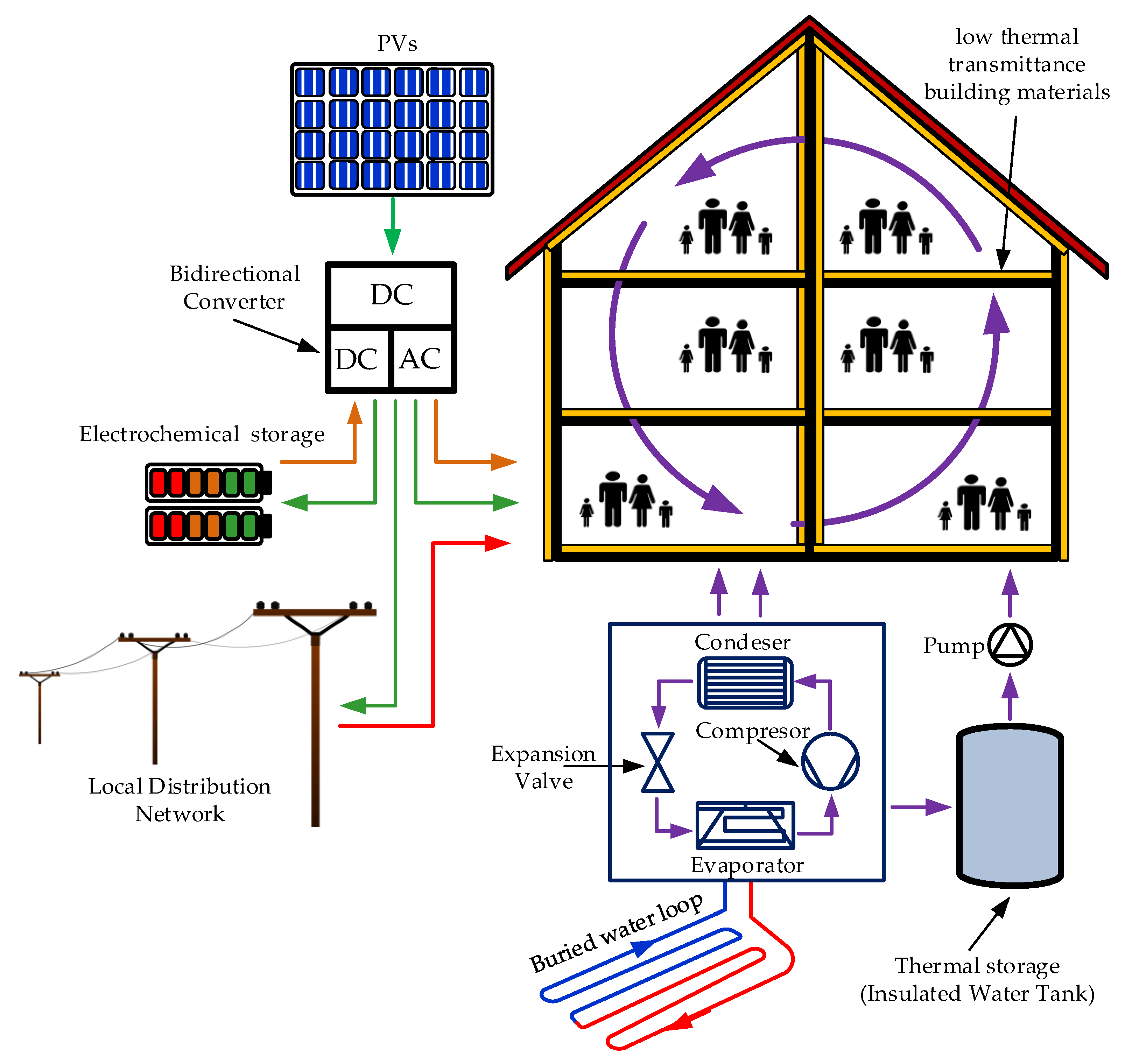
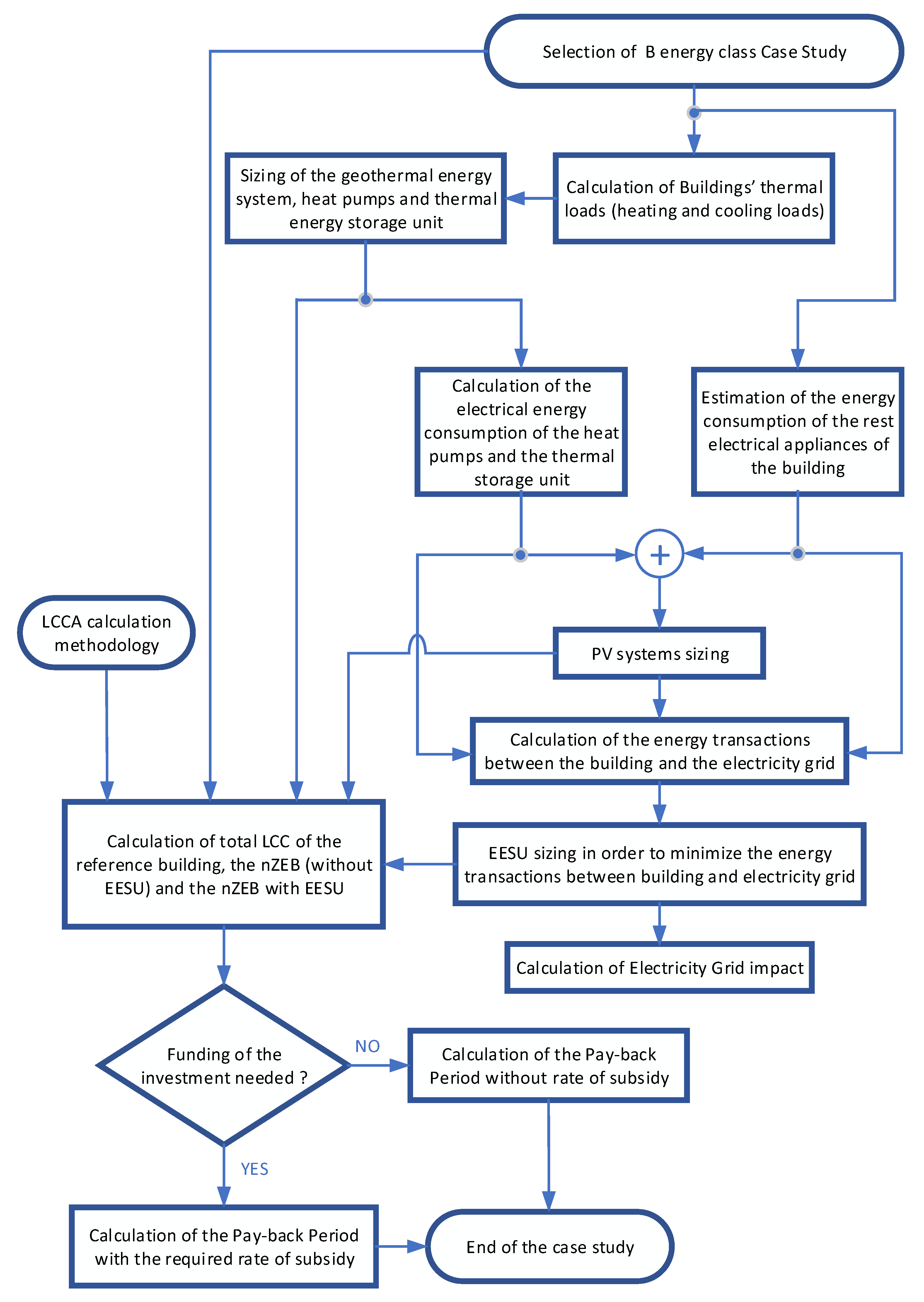
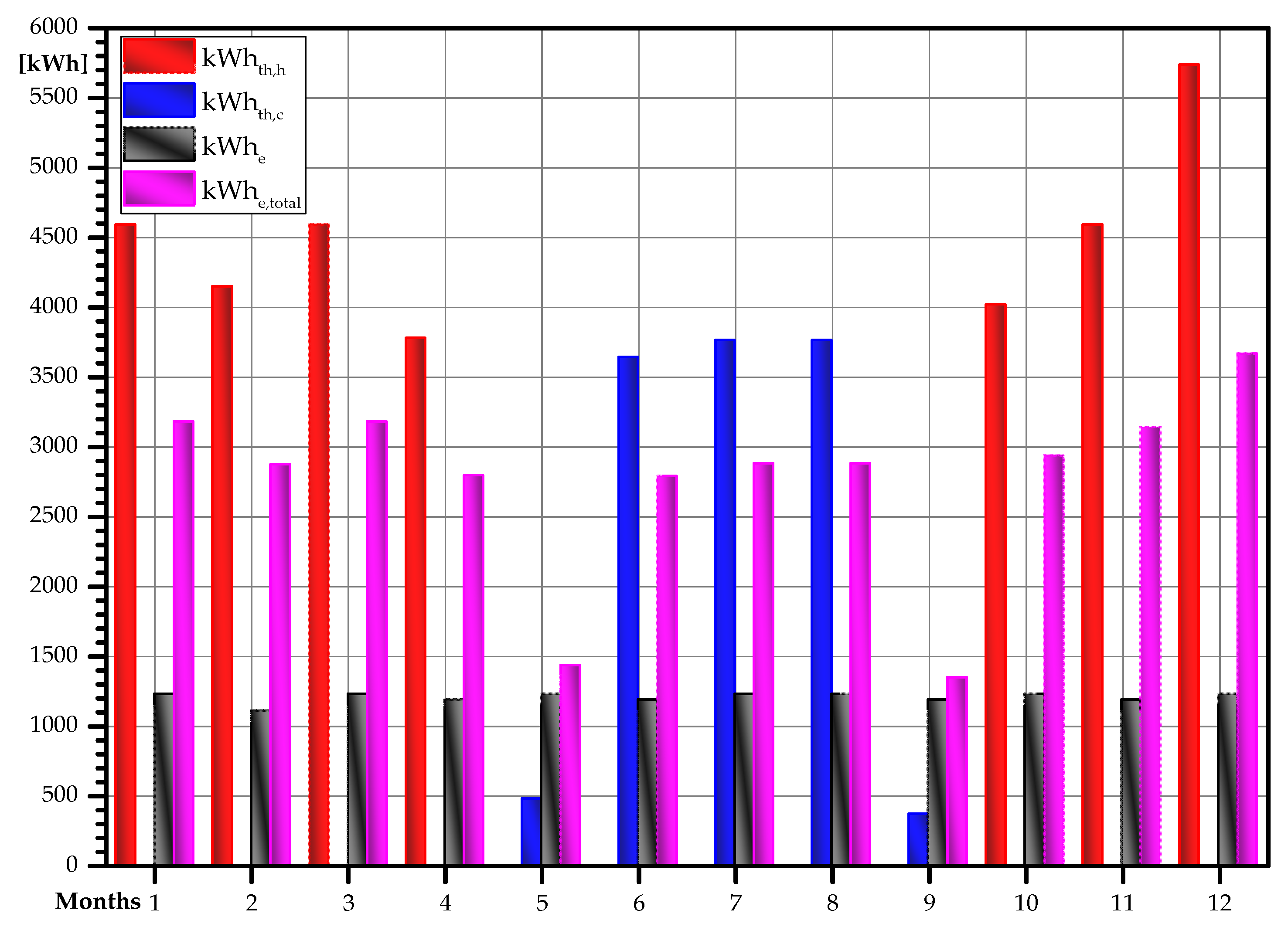

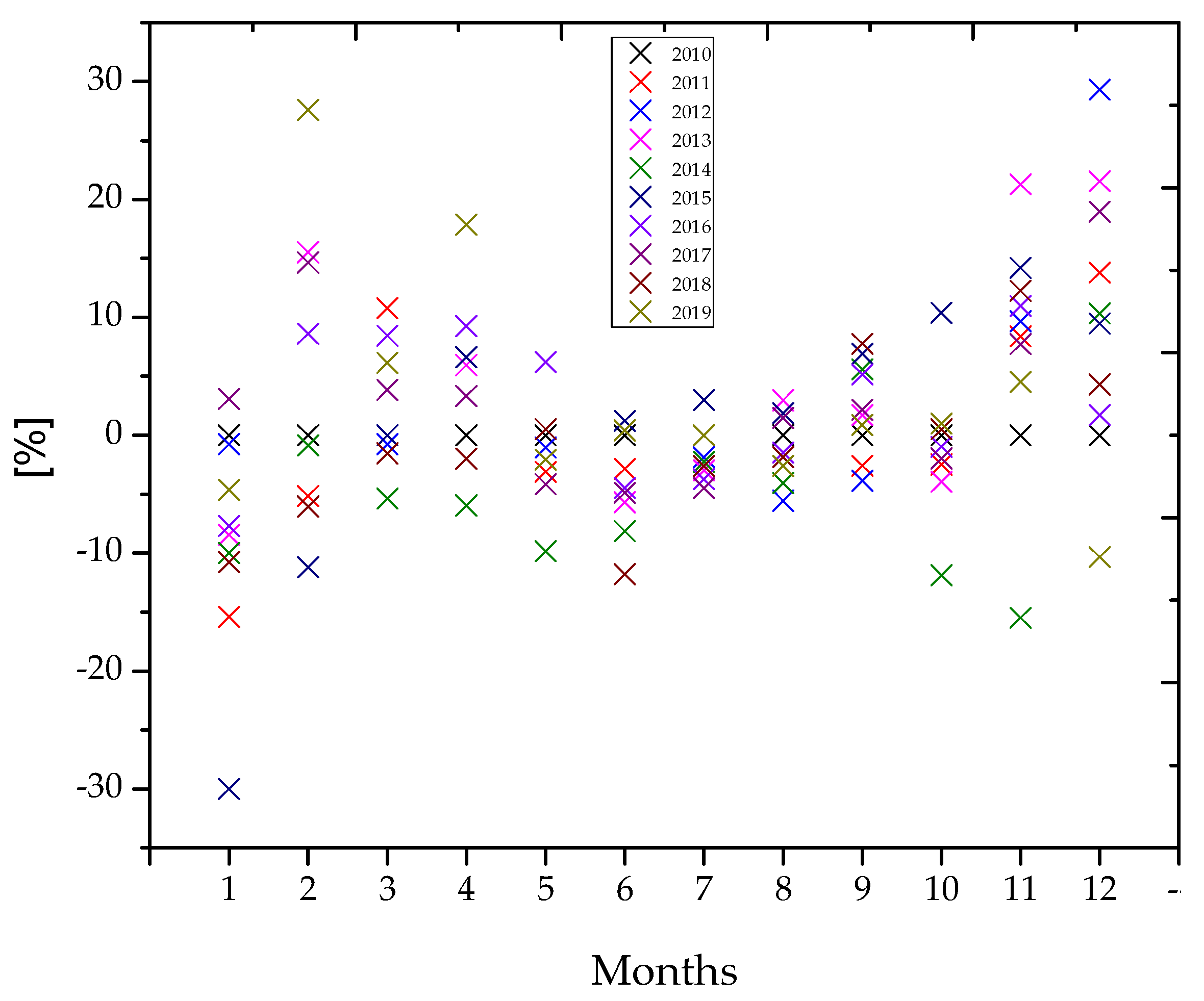
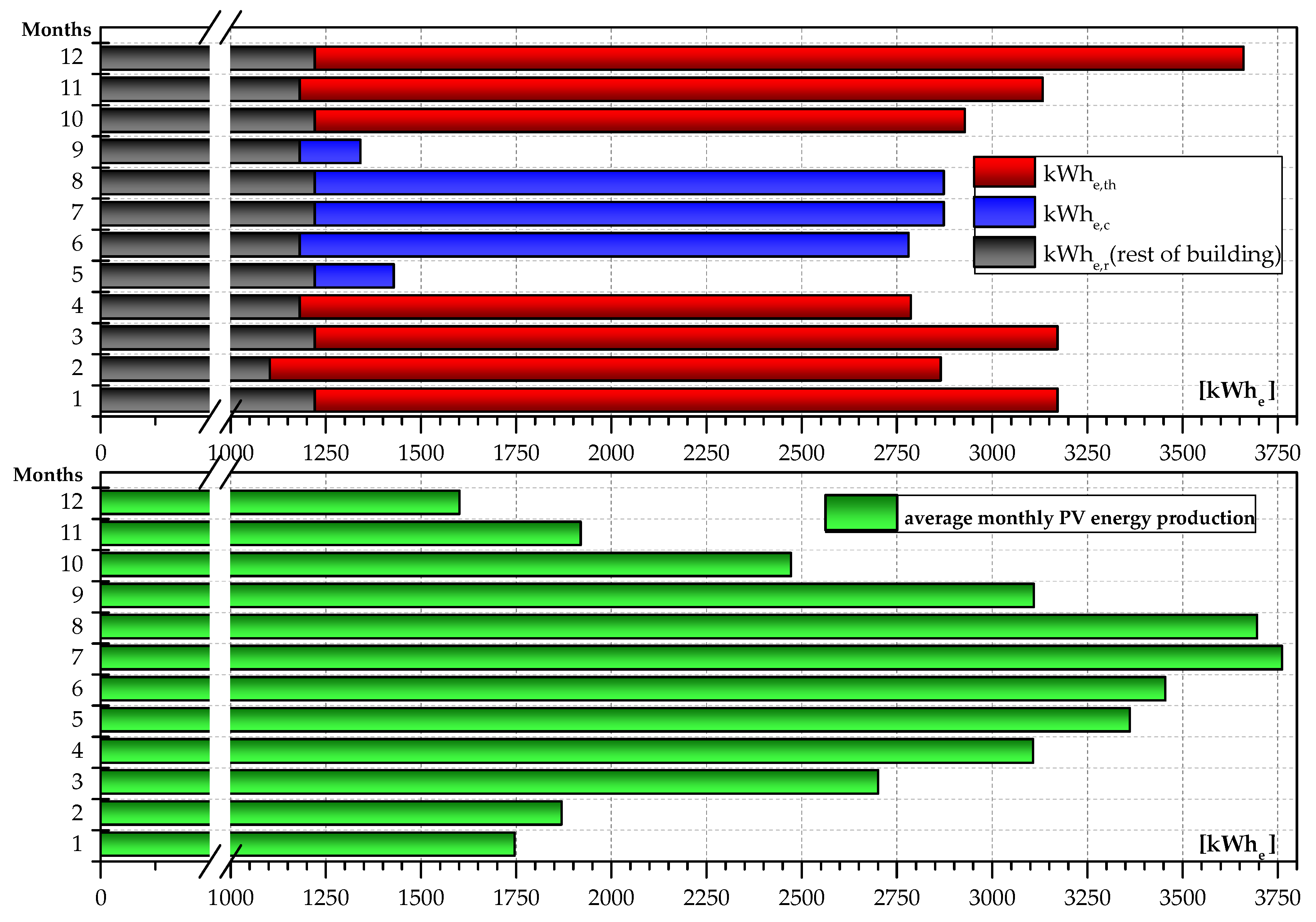
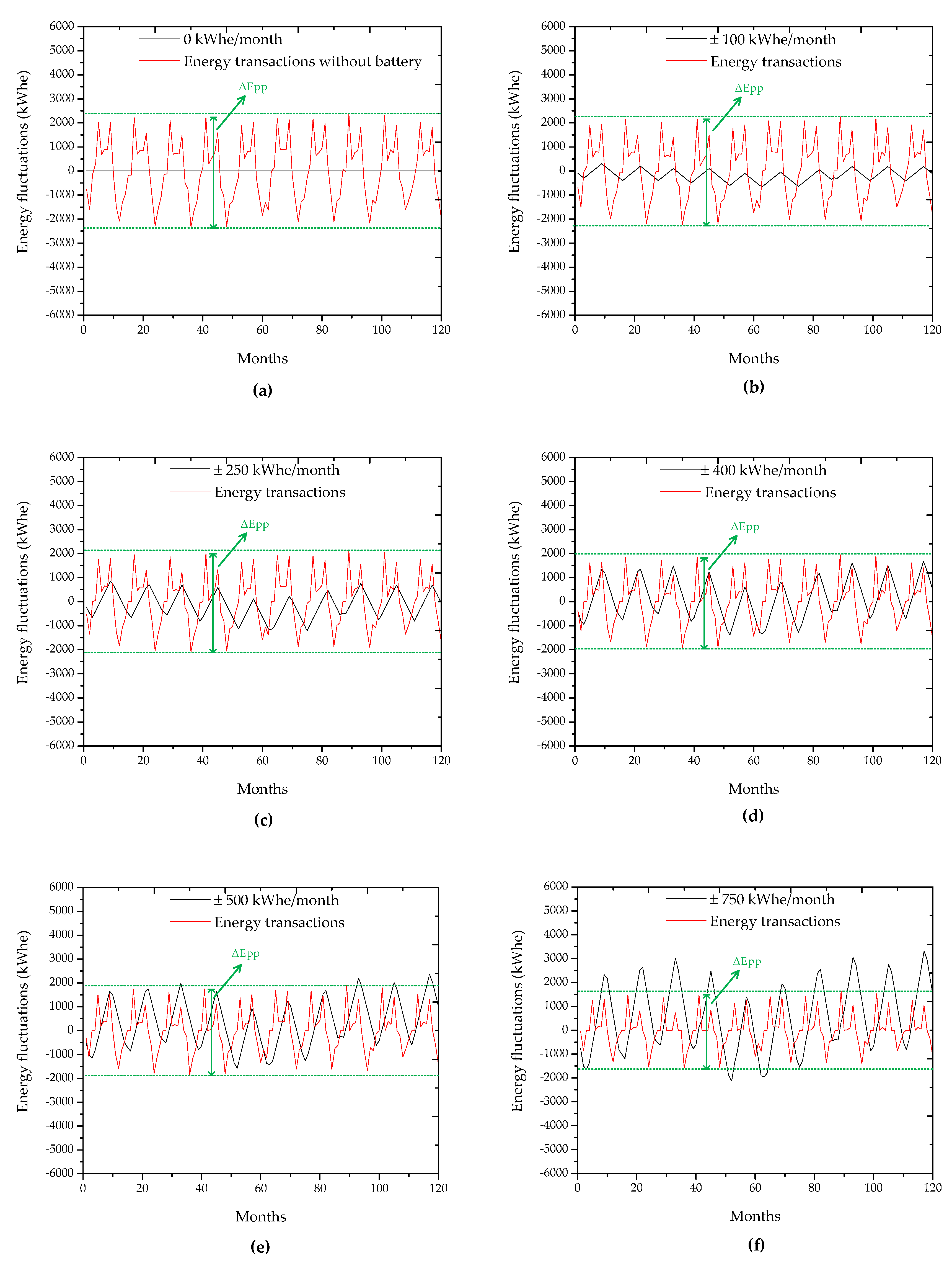
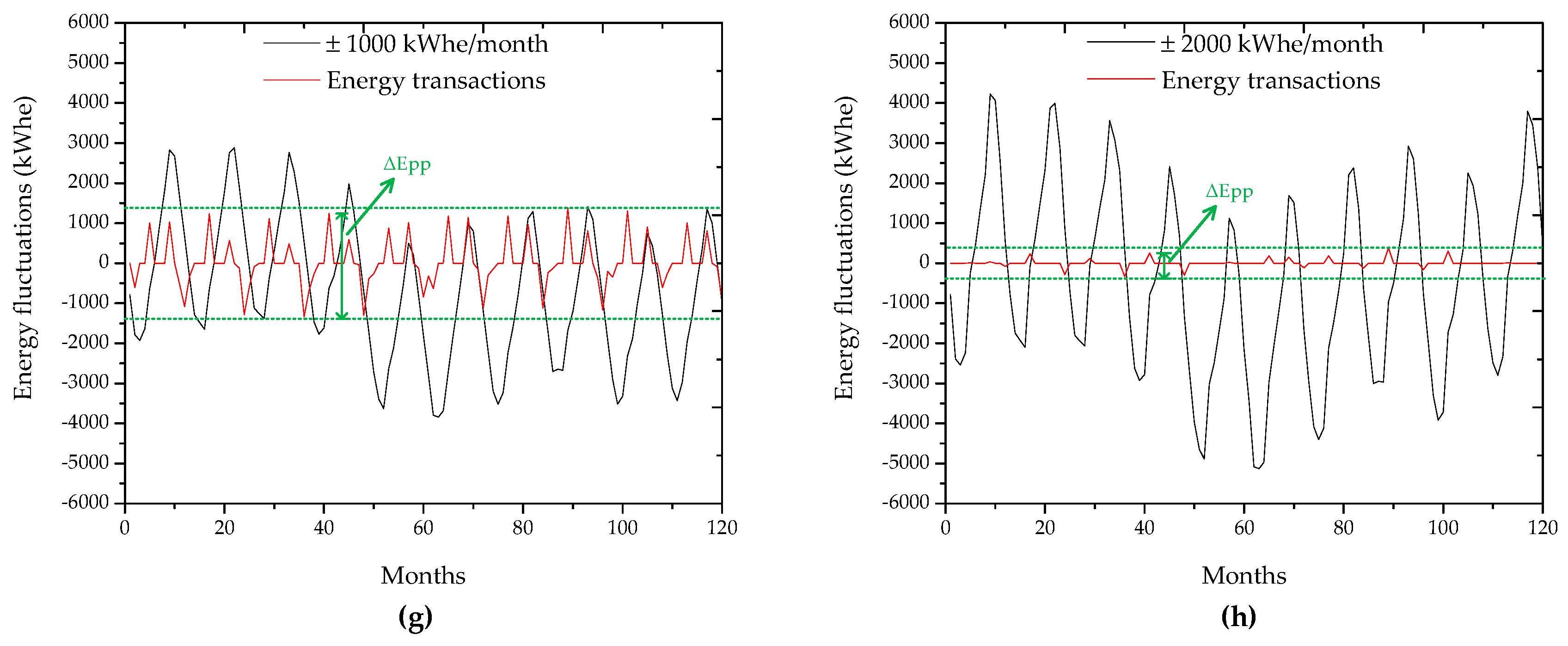
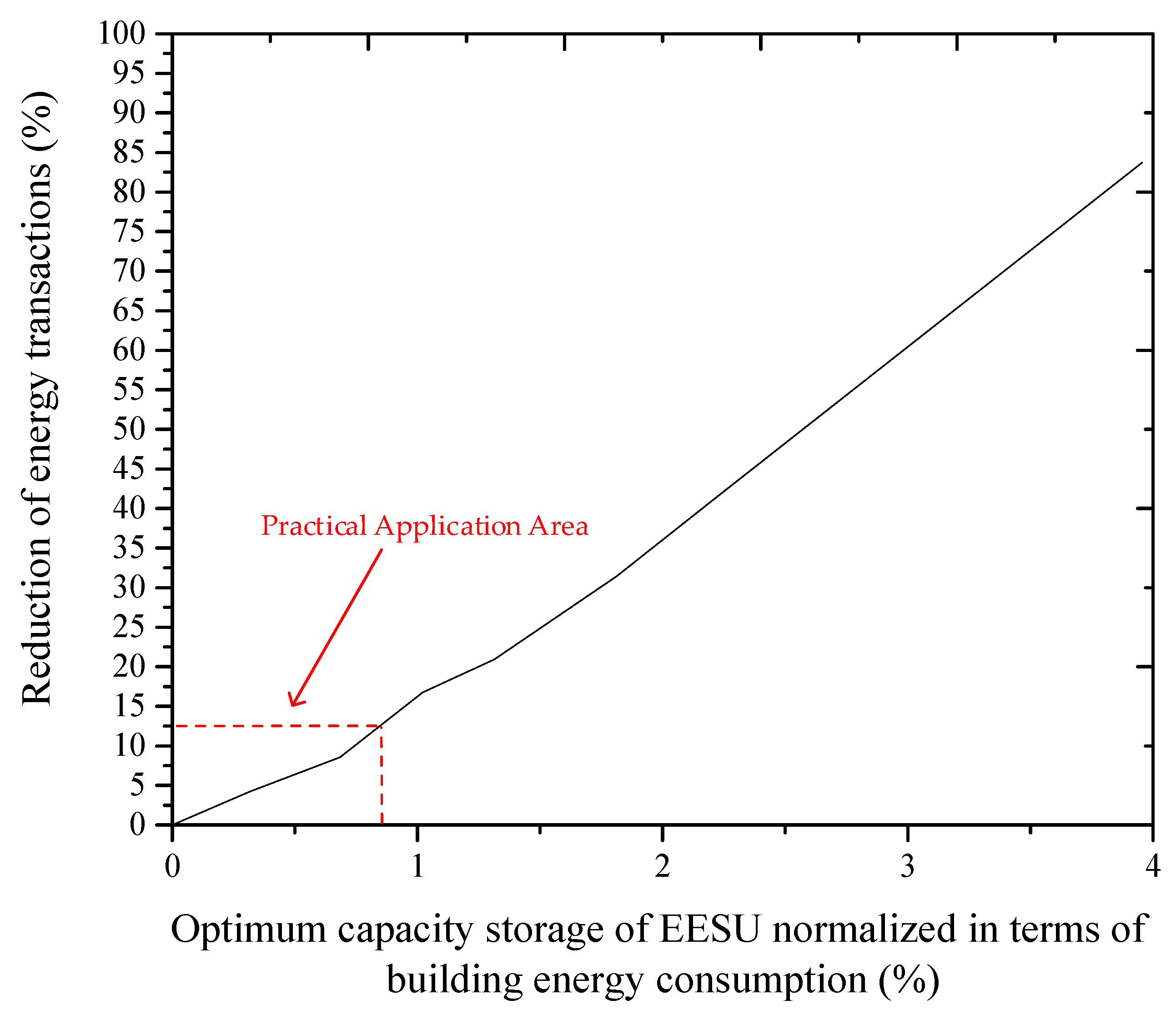
| Energy Source | Primary Energy Factor | Emissions kg CO2/kWh |
|---|---|---|
| Natural Gas | 1.05 | 0.196 |
| Heating Diesel | 1.1 | 0.264 |
| Electric Energy | 2.9 | 0.989 |
| LPG | 1.05 | 0.238 |
| Biomass | 1 | - |
| District heating by thermal stations | 0.7 | 0.347 |
| District heating by RES | 0.5 | - |
| GHP Technical Data | HPSU Technical Data | |
|---|---|---|
| Heating capacity (kWth,h) | 22.26 | 71.8 |
| Cooling capacity (kWth,c) | 24.9 | 50.5 |
| COP | 3.13 | 5.04 |
| EER | 4.4 | 3.46 |
| Cstorage (kWh) | Maximum Permitted EESU Energy Fluctuations Per Month (kWhe/Month) |
|---|---|
| 1040 | ±100 |
| 2264 | ±250 |
| 3377 | ±400 |
| 4342 | ±500 |
| 5988 | ±750 |
| 7400 | ±1000 |
| 13,080 | ±2000 |
| Cstorage (kWh) | ΔEgrid,month (kWh) | Reduction of Energy Transactions (%) | Optimum Storage Capacity Normalized in Terms of Building Energy Consumption (%) |
|---|---|---|---|
| 0 | 2389 | 0 | 0 |
| 1040 | 2289 | 4.19 | 0.31 |
| 2264 | 2184 | 8.58 | 0.68 |
| 3377 | 1989 | 16.75 | 1.02 |
| 4342 | 1889 | 20.93 | 1.31 |
| 5988 | 1639 | 31.40 | 1.81 |
| 7400 | 1389 | 41.86 | 2.23 |
| 13,080 | 389 | 83.73 | 3.95 |
| Economic Parameters | |
| Discount rate, d | 0.25%, 0% (*) |
| Inflation rate, g | 0.30% |
| Borrowing rate, i | 0% |
| Down payment, D Escalation of energy costs, e | 0% 0.50% |
| Time Parameters | |
| Period of analysis, N | 25 years |
| Borrowing period, NΔ | 10 years, 0 years (*) |
| (*) Values that correspond to the LCCA of the initial building | |
| Cstorage (kWh) | LCCTOTAL (€) | Total Initial Cost (€) | Funding for the Investment (€) | Rate of Required Subsidy (%) |
|---|---|---|---|---|
| 0 | 289k€ | 114k€ | 26k€ | 23.31 |
| 100 | 376k€ | 146k€ | 113k€ | 77.60 |
| 250 | 424k€ | 170k€ | 160k€ | 94.44 |
| 400 | 447k€ | 194k€ | 184k€ | 94.50 |
| 500 | 503k€ | 211k€ | 240k€ | 113.83 |
| 750 | 582k€ | 251k€ | 319k€ | 127.01 |
| 1000 | 662k€ | 292k€ | 398k€ | 136.5 |
| 2000 | 979k€ | 454k€ | 716k€ | 157.52 |
| Cstorage (kWh) | Total Absorbed Energy on 25 Year Basis (MWhe) | Total Cost of Absorbed Energy (€) |
|---|---|---|
| 0 | 159.2 | 6949 |
| 100 | 156.9 | 6848 |
| 250 | 152.6 | 6662 |
| 400 | 150.1 | 6554 |
| 500 | 146.5 | 6395 |
| 750 | 142.4 | 6215 |
| 1000 | 137.2 | 5991 |
| 2000 | 116.7 | 5097 |
© 2020 by the authors. Licensee MDPI, Basel, Switzerland. This article is an open access article distributed under the terms and conditions of the Creative Commons Attribution (CC BY) license (http://creativecommons.org/licenses/by/4.0/).
Share and Cite
Kotarela, F.; Kyritsis, A.; Papanikolaou, N. On the Implementation of the Nearly Zero Energy Building Concept for Jointly Acting Renewables Self-Consumers in Mediterranean Climate Conditions. Energies 2020, 13, 1032. https://doi.org/10.3390/en13051032
Kotarela F, Kyritsis A, Papanikolaou N. On the Implementation of the Nearly Zero Energy Building Concept for Jointly Acting Renewables Self-Consumers in Mediterranean Climate Conditions. Energies. 2020; 13(5):1032. https://doi.org/10.3390/en13051032
Chicago/Turabian StyleKotarela, Faidra, Anastasios Kyritsis, and Nick Papanikolaou. 2020. "On the Implementation of the Nearly Zero Energy Building Concept for Jointly Acting Renewables Self-Consumers in Mediterranean Climate Conditions" Energies 13, no. 5: 1032. https://doi.org/10.3390/en13051032






